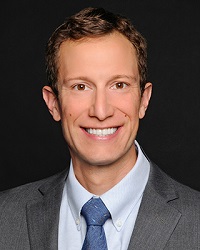
Scott E. Klass, MD, MS, ATC
PGY4, University of Miami/Jackson Health System PM&R Program
At some point in everyone's training, they run into a situation where they feel completely unprepared. This frequently occurs when learning the skill-based competencies in PM&R such as EMG, interventional pain, Botox injections, physical exam and musculoskeletal ultrasound. To be proficient, these skills require a lot of hands-on practice and rarely have a go-to resident level resource. Fortunately, in this challenge lies opportunity. This is why my co-resident, Dr. David Valdes, and I decided to create a new ultrasound curriculum at the University of Miami. To maximize our extracurricular reward for undertaking such a big project, we turned it into a Quality Improvement (QI)/clinical research project and are working with AAPM&R to provide this resource to a broader audience. This allowed us to simultaneously learn a future career skill, gain valuable teaching experience, complete our required projects and give back to our residency.
To create the course, we started by identifying a primary resource: the Sports Ultrasound Online videos from the American Medical Society of Sports Medicine (AMSSM), that are in collaboration with AAPM&R. Access to these videos can be found on the AMSSM website or as part of AAPM&R's Education Subscription or a-la-carte on the AAPM&R Online Learning Portal*. While watching the videos, we took notes and screenshots. Then we would meet up weekly after hours in our ultrasound clinic to perfect our scans. While we practiced, our goal was to break everything down to the basics for a strong foundation. We identified the learning issue with ultrasound as mostly stemming from getting lost in the anatomy and not having a set routine. To fix this, we established easy to find "home bases" in each plane of the joint to orient ourselves and created a routine to move seamlessly between structures.
After learning the scans, we used our notes to create a book with the title, "The Ultimate Guide to Ultrasound Gainz," as a reference for practicing residents. To make the book, we found basic Google anatomy images that correlated to the ultrasound anatomy and added arrows and stars next to the structures. We then edited the text and wrote out a routine for quick review. To account for the PGY year experience difference, we created both a basic structures checklist that focused on the must know anatomy for all residents and a comprehensive checklist for those looking to learn ultrasound on sports medicine fellow level. Upon completion we printed 4 copies in color, placed the pages into protected sleeves and organized them into upper and lower extremity books so that we could use them during our hands on practice and ultimately leave them as our legacy to the program.
Our course structure consisted of a once monthly evening session from 4-7 pm, with a one hour lecture and a two hour live scan. The session topics started with the upper extremity and progressed to the lower extremity with a review session after completing all upper extremities and again after all lower extremities. At the end, we had an OSCE examination administered by our attendings with clinical scenarios in which we had 10 minutes to identify certain structures in 2 joints. The lectures consisted of an introduction to ultrasound followed by joint specific PowerPoints using a drawing tool that allowed us to demonstrate probe placement and the routine.
In the clinical scan, we broke our 24 residents into 4 groups of 2-3 residents who scanned each other for one hour until everyone could find at least the basic structures. During the scan, David and I, along with our musculoskeletal attendings, Dr. Irwin and Dr. Tiu, led each group through the routines as simply as possible using the books for reference anatomy. So that every group had its own machine, we obtained additional ultrasounds by contacting our local reps. At the end of the course, we recruited 4 of our rising PGY4's to continue to improve upon the course for the next generation, which will serve as a great leadership opportunity that we created for them.
Completing the course came with many challenges. One was convincing our faculty to let us run the course. We overcame that by presenting our vision with actual notes, which demonstrated the value we could bring. We also asked key faculty to collaborate and presented it as a research project. Another obstacle was frequently adjusting the material and delivery to best meet our learners' needs. It is important to build rapport and have clear communication with your co-residents and faculty. Ultimately, working with a partner was the most crucial help to brainstorm ideas, keep each other going and have fun doing it.
My goal with sharing this experience is to inspire others to think of what legacy you want to leave in our field and to realize if there's something you want to learn you just have to dedicate time to do it. If you are working on projects within your program to expand resident education and knowledge within the field, I encourage you to reach out to the Academy and let us know what you are working on. AAPM&R is looking to help share resources for residents, by residents. It's my hope that all residents can collaborate through organizations like the AAPM&R to create best practice resources and share them so that every resident has a go-to resource to improve our field and enhance our collective PM&R brand in the field of medicine.